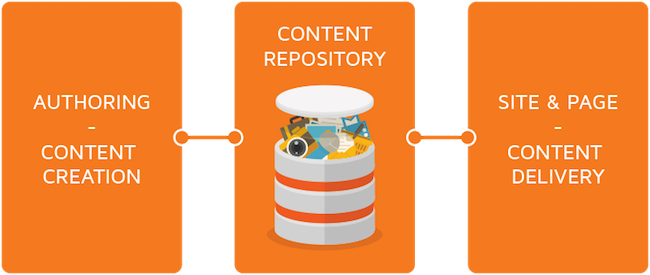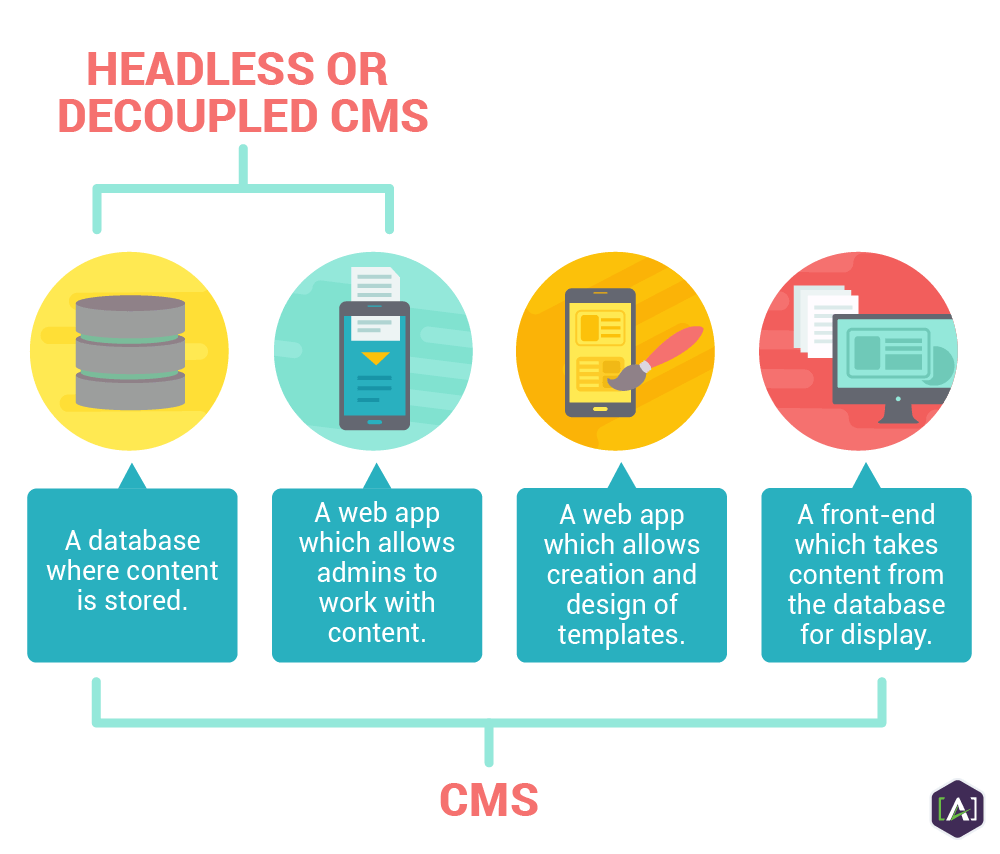Losing Our Heads
The headless CMS
If there’s a universal truth in modern business, it’s that technology is always evolving, and companies that succeed are invariably the ones that take full advantage of these advances. Content management systems (CMS) are a powerful case in point. The technology was created to improve businesses’ ability to release and edit content on the web. CMS websites have lowered the cost and enhanced the process of marketing online. One of the most recent, and arguably more important improvements with CMS technologies, is the development of the headless and the decoupled CMS. This relatively new approach is helping companies to overcome some of the biggest roadblocks to modern content management. What is a Decoupled Content Management System? To comprehend the benefits of decoupled content management systems, it’s important to first understand what decoupling involves, and how decoupled systems differ from previous CMS models. Traditionally, a CMS involves a single, unified application, which is connected to a database containing templates, editing tools, and a range of other features used to create, publish, and modify content. The monolithic nature of these systems makes them relatively easy to use, but it also creates a number of problems, including:- Static Presentation A traditional CMS will typically present your content in one particular way. But modern marketing content needs to be accessible on a wide range of different devices, which often have distinct presentation needs. If readers have trouble opening up and viewing content on their preferred device, they will be less likely to engage and share it.
- Application Limitations Traditional content management systems are tied to specific templating and editing tools. As new applications become available, if they are not compatible with your CMS, you may miss out on opportunities to improve the publishing and editing process.
- Compromised Efficiency Traditional content management systems typically have a set of complicated rules governing how all of their different functions interact with one another. So many rules can bog the system down, making it harder for you to use it in response to sudden and pressing content needs.
 Each of these functions can be performed independently of the others, giving your company more flexibility in how the CMS is leveraged. The content repository, for example, can give you content models from Midgard2, CouchDB, JCR, or PHPCR. Likewise, you could use Neos, Drupal, Django, Midgard MVC, or CodeIgniter for the web framework, which creates web pages based on the specific content you are trying to publish. Finally, you can use a range of different web editing tools, and when you make edits to your pages, there is no need to implement the entire CMS again. Your company will have maximal control over which applications you use, and can mix and match different options to suit your specific needs.
Each of these functions can be performed independently of the others, giving your company more flexibility in how the CMS is leveraged. The content repository, for example, can give you content models from Midgard2, CouchDB, JCR, or PHPCR. Likewise, you could use Neos, Drupal, Django, Midgard MVC, or CodeIgniter for the web framework, which creates web pages based on the specific content you are trying to publish. Finally, you can use a range of different web editing tools, and when you make edits to your pages, there is no need to implement the entire CMS again. Your company will have maximal control over which applications you use, and can mix and match different options to suit your specific needs. The Difference Between a Headless CMS & Decoupled CMS
It’s important to distinguish decoupled CMS from a headless content management system, which are related but have some distinct differences. A headless CMS lacks templating, framework, and other tools that determine how content appears to the end user, leaving it up to your company to take care of these details. By contrast, a decoupled CMS does have these features, though it does not require you to use them. Headless content management systems do have a number of advantages for companies that are confident designing their own templating and formatting applications. But if you don’t have the internal resources and expertise to support this approach, a decoupled CMS is a better approach. As with most investments in new technology, it’s important to find the system that best matches your organization’s needs and abilities.
How Can Your Organization Benefit from a Decoupled CMS?
The single most important benefit of adopting a decoupled CMS is that it allows your company to adapt to future needs. New devices, software applications, and cultural trends are redefining the way in which users search for, engage and consumer digital experiences. With a traditional CMS, it will be costly and difficult for you to update your content in response to these trends. As a result, you’re unlikely to avoid such an update until you realize it is absolutely necessary, by which point you’re already missing opportunities. Decoupling is Powerful By contrast, with a decoupled content management system, you can respond to new technologies and consumer trends proactively. If people begin using a new type of device, for example, you can start experimenting with new ways to format your content so that it is accessible on such devices. Because the cost of such experiments is low, you can afford to go through an iterative process to find the right format. Not only can you develop new formats and other practices more quickly, you’re more likely to find ones that actually better serve your needs. Decoupling is Future-Proofing Decoupling your CMS allows you to easily adopt new methods and technologies of managing your digital experience. Say that a new editing tool comes out that has fewer bugs or gives you more flexibility compared to the one you are currently using. Because the editing features are not coupled to the rest of the CMS, you’re able to adopt this new tool as soon as you realize its value. As a result, you can save money and improve quality at an earlier stage, maximizing the benefits for your company. These advantages are only the beginning of how a decoupled CMS can enhance your digital experience. Other benefits include:- Improving Interactivity Decoupled content management systems can interact directly with users and respond to their needs. This makes it easier for you and your employees to take full advantage of the system and tailor it to the specific goals and challenges of your company.
- Streamlining Your Site As a decoupled CSM is not governed by complicated rules, they tend to operate more quickly and efficiently than their traditional counterparts. This means that you will be able to publish new content and edit existing pieces more rapidly. Considering the need to tie content to trending events and opportunities, this has the potential to dramatically increase user engagement with your content.
- Enhancing Readability a Accuracy Because decoupled systems allow you to edit content more quickly and at a lower cost, you will be able to correct problems as soon as you notice them, improving the quality of your digital experience.
Main photo by Pana Vasquez on Unsplash



